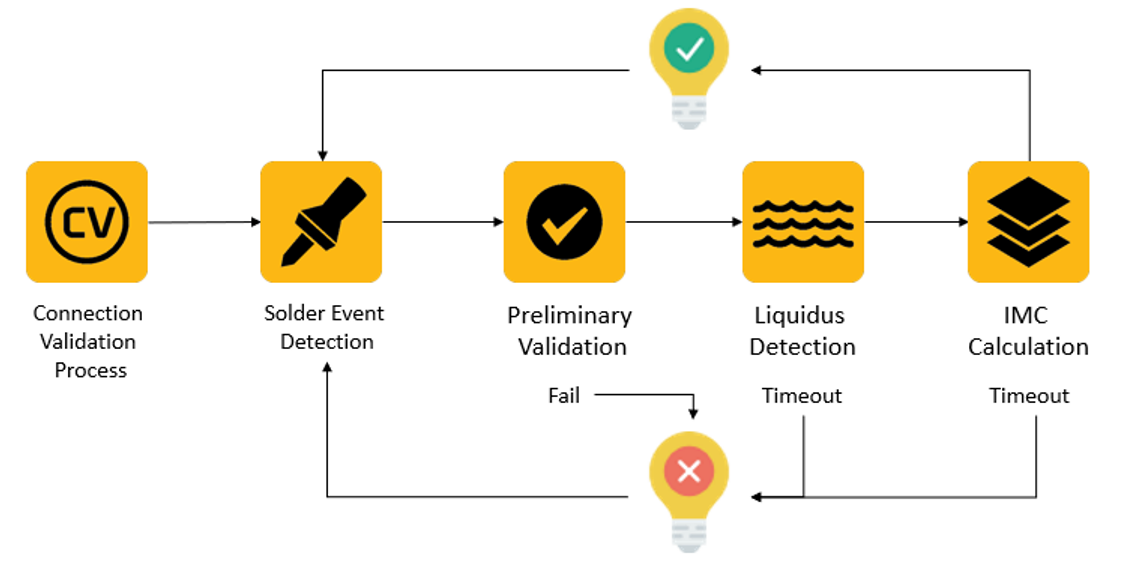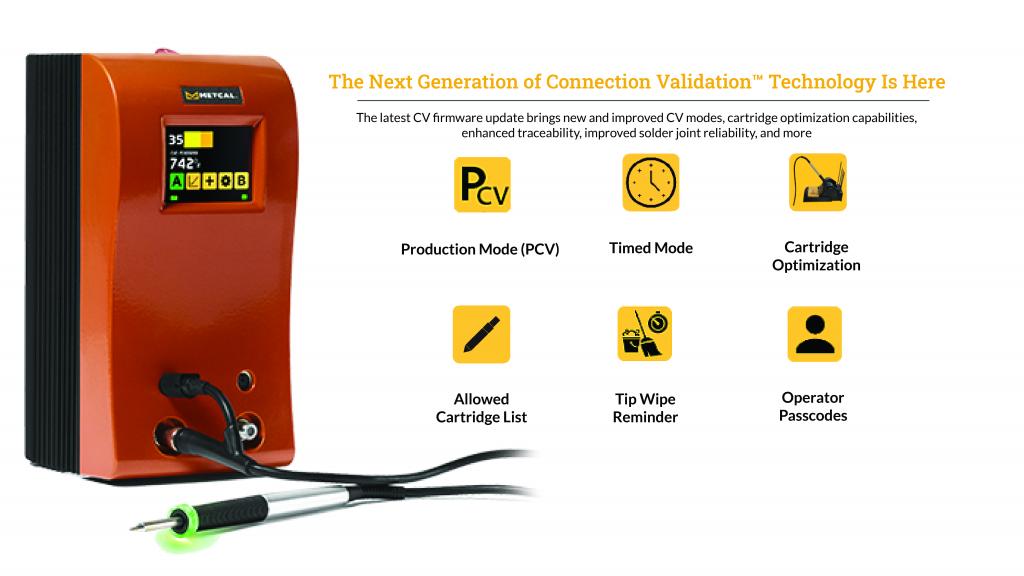5 min read
The latest CV firmware update from Metcal brings new and improved CV modes, cartridge optimization capabilities, enhanced traceability, improved solder joint reliability, and more. The update vastly improves the already one-of-a-kind functionality of Connection Validation™ technology. This update is the result of years of research and input from process engineers, operators, customers, and industry experts, and promises to be a significant advancement in hand soldering.
TOPICS COVERED
The Outdated Process of Visual Solder Joint Inspection
Connection Validation™ Is Far Superior to Simple Visual Inspection
Connection Validation™ Technology Calculates the Intermetallic Compound (IMC) Formation of Each Joint
New & Improved CV Modes for Production and Process Control
Additional CV Upgrades Improve Efficiency and Process Control
Take Full Advantage of the New & Improved CV Features
Connection Validation™ Resources and Downloads
The Outdated Process of Visual Solder Joint Inspection
The best time to catch a faulty solder joint is at the workbench. But, for many decades, the only way to verify the quality of a solder joint was through visual inspection, either at the workstation or long after the soldering process was complete.
At the workbench, operators would simply look at each joint to see if it appears to be well made, and draw conclusions based on the fillet height and the amount and finish of the solder.
Long after the assembly has been soldered (and a failure has been found) there are ways to inspect joints by examining a cross-section of the soldered board or x-raying the assembly.
But accurate validation of the quality of solder joints at the workbench, when it is the most critical, was simply not possible. Until Connection Validation™.
Connection Validation™ Is Far Superior to Simple Visual Inspection
Connection Validation™ (CV) soldering systems from Metcal give operators immediate feedback when a quality solder joint has been made. This innovative technology verifies the integrity of each joint in real time and alerts the operators when the process is complete through closed-loop feedback.
There is no longer the need to rely only on visual inspection or the operators’ intuition.
Connection Validation™ Technology Calculates the Intermetallic Compound (IMC) Formation of Each Joint
To understand how Connection Validation™ works, we need to understand something called intermetallic compound formation.
A Reliable Solder Joint Requires IMC Formation
Soldering is simply the joining of two metals using a filler material, in this case, solder. The two metals are joined because of the formation of the IMC, where the solder and the other metals bond.
Proper IMC formation is required to successfully bond the solder and the component termination and/or the board substrate. If the IMC is too thin, the joint will be too fragile and most likely fail. If the IMC is too thick, it will cause unreliable joints by becoming too brittle and breaking.
For a truly successful solder joint, the operator must find the balance between time on the joint and tip temperature to create a joint with proper IMC formation.
Metcal CV Soldering Systems Calculate IMC Formation
Metcal has designed the Connection Validation™ system to give station operators immediate, closed-loop feedback on the IMC formation of each joint.
The CV technology calculates each joint’s IMC formation as it is being made and passes the validation alert on to the operator via a green LED ring light embedded in the handpiece. If the joint does not pass the validation process, or the soldering tip is on the joint beyond the IPC standard, the LED flashes red.

The Connection Validation™ process includes Solder Event Detection, Preliminary Validation, Liquidus Detection, and IMC Calculation. To achieve a green light on the handpiece, the joint calculations must pass each step.
Connection Validation™ is the best method available to successfully evaluate solder joints at the moment of their creation.
New & Improved CV Modes for Production and Process Control
With the release of the latest firmware, Connection Validation™ soldering systems have a set of new and improved features, the most vital of which are the new Connection Validation™ Modes.
PRODUCTION MODE (Pcv)

In Production Mode (Pcv), the Connection Validation™ system verifies the IMC formation of each joint and signals the operator via the handpiece LED and an optional audible signal at the end of each validation cycle:
- PASS: Green LED light and (optional) audible beep, indicating the joint has passed validation
- ABORT: Red LED light and (optional) audible buzz, indicating the tip was lifted off the joint too soon and the event did not pass validation
- TIMEOUT: Red LED light and (optional) audible buzz, indicating the tip has been on the joint too long. This feature is to help prevent the operator from delaminating the PCB or causing lift-off of the pad. This is a preprogrammed eight (8) second time out, based on IPC Standard J-STD-001.
Production Mode is a new advanced mode of Connection Validation™, with faster verification and more reliance on the operator to achieve a successful joint than previous versions. This mode is for experienced operators who may have found the previous versions of CV too slow. (Not available in Dual Output Mode)
TIMED MODE
 In Timed Mode, the user or process manager sets an appropriate time-on-joint, based on the application and the temperature of the cartridge being used. The CV system times the dwell time of each joint and alerts the operator when they should remove the solder tip and move on.
In Timed Mode, the user or process manager sets an appropriate time-on-joint, based on the application and the temperature of the cartridge being used. The CV system times the dwell time of each joint and alerts the operator when they should remove the solder tip and move on.
The length of the time-on-joint is set on the Timeout Settings screen (Icon 2), within a range of 3 to 8 seconds (IPC Standard).
This is a valuable mode when the desired temperature and exact dwell time can be determined in advance, to maintain consistency among the operators.
CV OFF

All Connection Validation™ systems are off. The CV unit operates like any other SmartHeat® system.
Additional CV Upgrades Improve Efficiency and Process Control
Along with the new CV Modes, the firmware update includes new and improved features:
- Cartridge Optimization System – to maximize the accuracy of the CV system, based on the precise impedance of your cartridges
- Allowed Cartridge Settings – to allow or restrict the use of specific cartridges for improved process control
- Tip Wipe Reminder – to remind operators to clean their cartridge tips
- Operator & Supervisor Passcode Settings – for lockout and improved traceability
For more information on all the new and improved CV features, download the CV Firmware Update Guide.
Take Full Advantage of the New & Improved CV Features
Enjoying the benefits of these new Connection Validation™ features will require that you update your firmware.
For a concise explanation of the firmware updating process, download our CV Firmware Update Instructions. For a complete explanation of the firmware update process, download the CV-5200 Firmware Update Loading Instructions or watch our How-To Upgrade Your Firmware video.
Go to Metcal.com for more information on Connection Validation™ Series Systems or any of our soldering, desoldering, rework, fume extraction, and fluid dispensing products. Or contact Metcal for further assistance.
Connection Validation™ Resources and Downloads
User Guide | Firmware Update Guide | Data Sheet | Tips & Cartridges Selection Guide
CV Firmware Update Instructions | CV-5200 Firmware Update Loading Instructions

